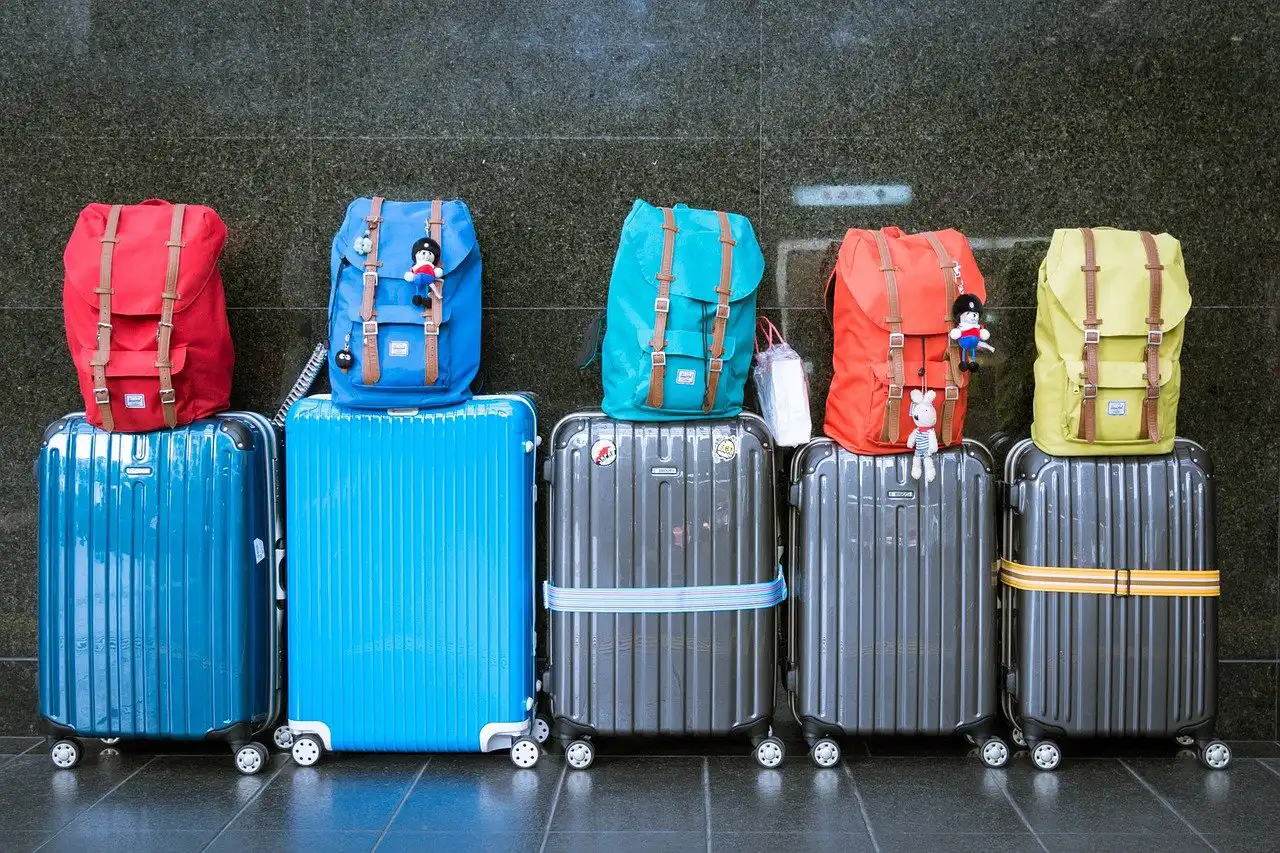By Timothy Hales | Updated: December 14, 2022
Yes, the TSA states that you can take your chef knives on a plane as long as they are in your checked bag. Be sure you appropriately sheath or wrap the knives so that they cannot injure the TSA or other inspectors of the bag. You may not take knives in your carry-on bag other than plastic or round bladder butter knives.
Why would I want to travel with my chef’s knife?
A kitchen knife may be the last thing on your packing list; however, there are some excellent reasons to include it for your trip. If you have recently stayed at a hotel or resort, you have probably found out that the knives provided in the kitchen are cheap and of low quality. Mutilating your meats and bread with the provided serrated knife is perhaps not ideal. If you plan to do a lot of cooking while away, you may find that having your kitchen knife is worthwhile.
Do you have to declare knives in checked luggage?
In the United States, You don’t have to declare a knife in your checked baggage, but you should know the laws of your destination country before traveling with one outside of the United States. A cooking knife is not normally an issue, but you should always check with your destination county to ensure you are not breaking any laws. And always make sure that you package your knife properly so that anyone who may inspect your baggage will not be injured.
How should I pack my chef’s knife?
It is essential to pack your kitchen knives properly to provide safety to those handling them and to prevent damage to your knives. The tip and blade of the knife should be completely covered so that there is no accidental stab or cut of yourself or someone inspecting your baggage. The chef’s knife should have little room to move around in the packaging or case. When packing your knives, you should consider whether you take a single chef knife or take several knives with you on your trip.
There are four different methods for packing your knives:
- Kitchen knife roll bag
- Knife edge guards
- Chef’s knife cover, sheath, or case
- Wrapping and Bundling
There are several methods for packing your knives. When deciding which one is best for your situation, you should consider the following:
- How many knives will you be taking? If you take more than one knife, you should consider using a knife roll bag or use the wrap or bundle method.
- Will you be traveling often with your knives? If you regularly travel with your knives, then it would be best to invest in a knife roll bag or some type of edge guard, sheath, or case. Bundling is easy to do with everyday household items, but it can be time-consuming if you do it before each trip.
- What will you be packing with your knife? If you are packing your knife in a suitcase with your clothes, it is easy to place a single knife in-between a layer of clothing to add protection. However, if you are packing your knife in a suitcase with other hard or metal items, you will want to add additional protection around your knives, such as bundling or a roll bag.
Kitchen knife roll bag
A knife roll bag is a case that protects your knives while also providing an easy way to store and transport your kitchen knives. The bag typically has several different compartments and Pockets to place your knives. They also allow you to roll the bag tightly to prevent damage to the knives. Knife roll bags are made of leather, canvas, or other textile materials. They are generally closed with plastic clips or buckles.
Knife edge guards
A knife edge guard, also known as an edge protector, blade guard, and blade cover, essentially goes over the knife’s cutting edge. Edge guards usually are made out of either plastic or nylon. When choosing an edge guard for your knife be sure that you consider the style and length of the knife to make sure it is adequately covered.
Chef’s knife sheath or case
Some chef knives come with a sheath that you could use when traveling. Usually, the sheath fits over the blade and locks in to place. You can also purchase a case that will cover the chef’s knife blade. You can also bundle a chef’s knife in a sheath or case in a towel to provide additional protection.
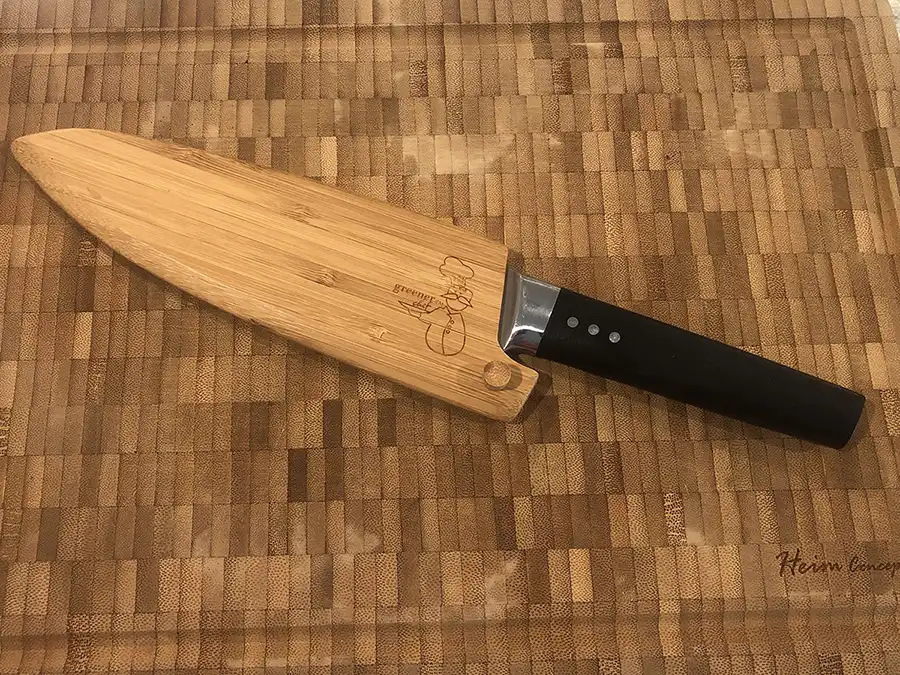
For example, I use this Victorinox BladeSafe case when I take my knife to other people’s houses or on vacation.
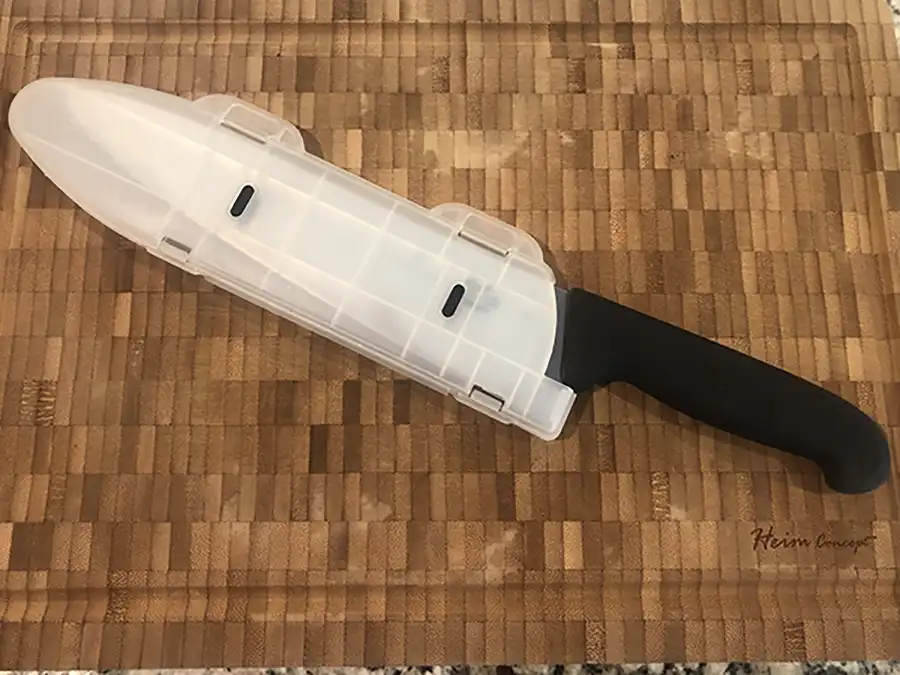
Wrap or bundle your knife
You can wrap or bundle your kitchen knives using a dishtowel or heavy-duty packing paper. This method allows you to wrap one or more knives together easily. The key here is to make sure that the towel or paper you are wrapping them in is thick enough to protect the blade’s tip edge. As you wrap the knives, leave enough space to completely cover each knife before being bundled up against another knife. Allowing extra material between knives will make sure that they do not bang together and damage each other. Once you have entirely wrapped your knives, you can use a rubber band or packing tape to keep the bundle tight.
Steps for wrapping your chef knives in a dishtowel:
- Place a large dishtowel on the counter in which to wrap knives.
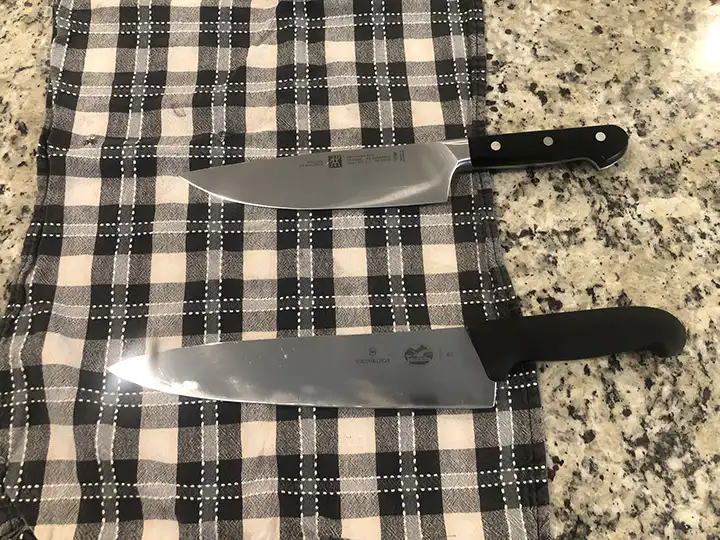
- Place knives on the dishtowel, leaving space between each.
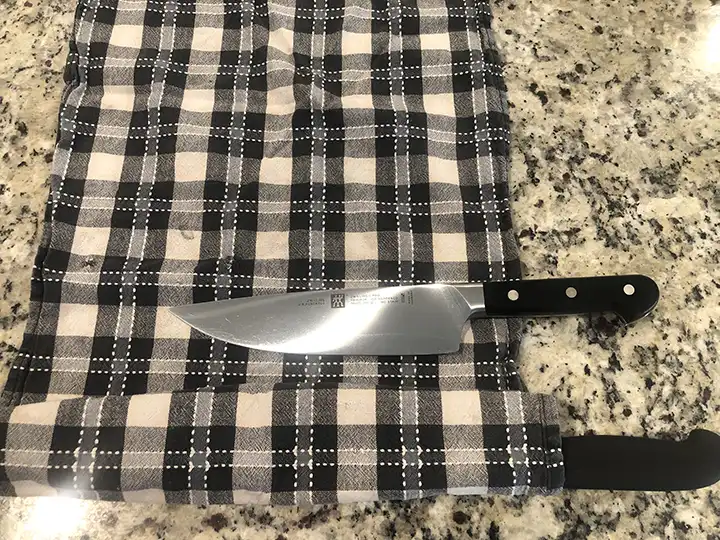
- Begin rolling the first knife in the dishtowel, and roll the second knife in the towel after you have completely covered the first knife. When rolling in the dishtowel, be sure to leave extra material at the end to fold over the tips.
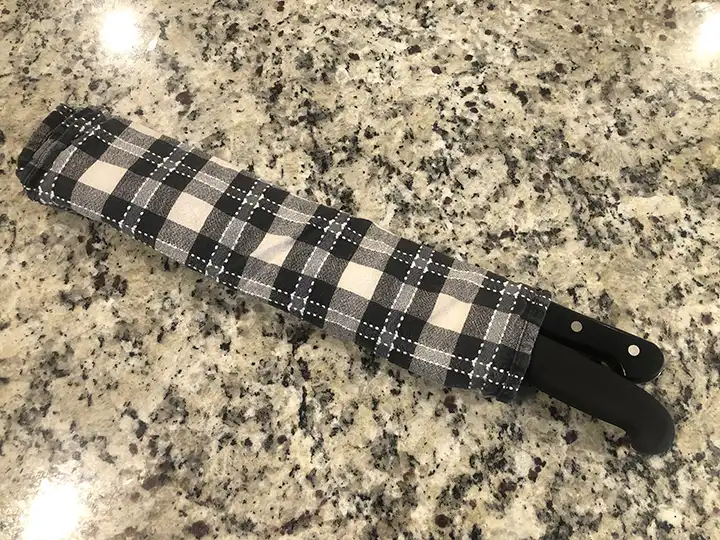
- Fold the towel over the tips and place a rubber band around each end of the bundle.

What other option do I have if I do not want to put my chef knives in my checked luggage?
If you are traveling with some expensive chef’s knives, then you may not want to put them in your checked luggage for fear of them getting damaged or stolen. You can use USPS, FedEx, or UPS to send your knives overnight or to your destination. Many hotels and resorts have package holding services, but you should always check with them before sending your knives. If you plan to ship your knives, you should follow the same packing tips as if you were putting them in your checked luggage.
What types of kitchen knives are okay to take in my carry-on bag?
The TSA allows plastic or flat rounded butter knives to be in your carry-on luggage.
What happens if I forget to take my chef knife out of my carry-on bag?
If you forget to take out your knife before reaching the airport checkpoint, you may encounter a few delays, but you shouldn’t have any criminal enforcement action towards you unless you have a meat cleaver. Carrying a meat cleaver can result in a fine of up to $2,090. Here is a list of allowed and prohibited items from the TSA.
If you are caught with your chef’s knife at the checkpoint, you have four options other than surrendering it to the TSA:
- Put it in a checked bag.
- Give it to the friend or relative who brought you to the airport.
- Take it back to your parked car.
- Use a mailer to ship it back home.
Final Notes
If you have any concerns with taking your kitchen knives on an airplane, it is always best to call the airline directly to confirm that you can take the knives on the airplane in checked luggage and the recommended way to secure them in your bag. Also, if you are flying internationally, then you will need to check in to local laws as some countries forbid carrying knives of any type.
